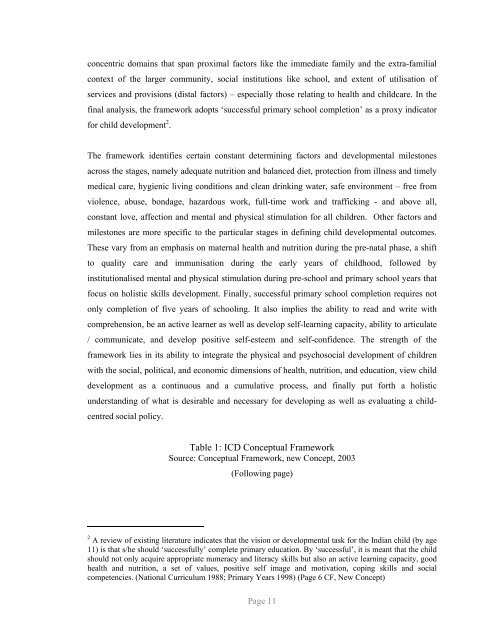Snakes and Ladders - ERU Consultants Pvt. Ltd.
Snakes and Ladders - ERU Consultants Pvt. Ltd.
Snakes and Ladders - ERU Consultants Pvt. Ltd.
You also want an ePaper? Increase the reach of your titles
YUMPU automatically turns print PDFs into web optimized ePapers that Google loves.
concentric domains that span proximal factors like the immediate family <strong>and</strong> the extra-familial<br />
context of the larger community, social institutions like school, <strong>and</strong> extent of utilisation of<br />
services <strong>and</strong> provisions (distal factors) – especially those relating to health <strong>and</strong> childcare. In the<br />
final analysis, the framework adopts ‘successful primary school completion’ as a proxy indicator<br />
for child development 2 .<br />
The framework identifies certain constant determining factors <strong>and</strong> developmental milestones<br />
across the stages, namely adequate nutrition <strong>and</strong> balanced diet, protection from illness <strong>and</strong> timely<br />
medical care, hygienic living conditions <strong>and</strong> clean drinking water, safe environment – free from<br />
violence, abuse, bondage, hazardous work, full-time work <strong>and</strong> trafficking - <strong>and</strong> above all,<br />
constant love, affection <strong>and</strong> mental <strong>and</strong> physical stimulation for all children. Other factors <strong>and</strong><br />
milestones are more specific to the particular stages in defining child developmental outcomes.<br />
These vary from an emphasis on maternal health <strong>and</strong> nutrition during the pre-natal phase, a shift<br />
to quality care <strong>and</strong> immunisation during the early years of childhood, followed by<br />
institutionalised mental <strong>and</strong> physical stimulation during pre-school <strong>and</strong> primary school years that<br />
focus on holistic skills development. Finally, successful primary school completion requires not<br />
only completion of five years of schooling. It also implies the ability to read <strong>and</strong> write with<br />
comprehension, be an active learner as well as develop self-learning capacity, ability to articulate<br />
/ communicate, <strong>and</strong> develop positive self-esteem <strong>and</strong> self-confidence. The strength of the<br />
framework lies in its ability to integrate the physical <strong>and</strong> psychosocial development of children<br />
with the social, political, <strong>and</strong> economic dimensions of health, nutrition, <strong>and</strong> education, view child<br />
development as a continuous <strong>and</strong> a cumulative process, <strong>and</strong> finally put forth a holistic<br />
underst<strong>and</strong>ing of what is desirable <strong>and</strong> necessary for developing as well as evaluating a child-<br />
centred social policy.<br />
Table 1: ICD Conceptual Framework<br />
Source: Conceptual Framework, new Concept, 2003<br />
(Following page)<br />
2 A review of existing literature indicates that the vision or developmental task for the Indian child (by age<br />
11) is that s/he should ‘successfully’ complete primary education. By ‘successful’, it is meant that the child<br />
should not only acquire appropriate numeracy <strong>and</strong> literacy skills but also an active learning capacity, good<br />
health <strong>and</strong> nutrition, a set of values, positive self image <strong>and</strong> motivation, coping skills <strong>and</strong> social<br />
competencies. (National Curriculum 1988; Primary Years 1998) (Page 6 CF, New Concept)<br />
Page 11












